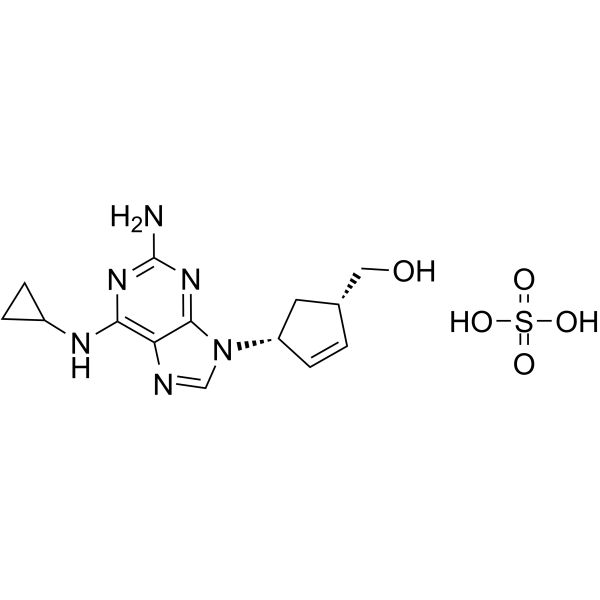| Description |
Abacavir monosulfate is a competitive, orally active nucleoside reverse transcriptase inhibitor. Abacavir monosulfate can inhibits the replication of HIV. Abacavir monosulfate shows anticancer activity in prostate cancer cell lines. Abacavir monosulfate can trespass the blood-brain-barrier and suppresses telomerase activity[1][2][3].
|
| Related Catalog |
|
| In Vitro |
Abacavir (15 and 150 μM, 0-120 h) monosulfate inhibits cell growth, affects cell cycle progression, induces senescence and modulates LINE-1 mRNA expression in prostate cancer cell lines[1]. Abacavir (15 and 150 μM, 18 h) monosulfate significantly reduces cell migration and inhibits cell invasion[1]. Abacavir monsulfate induces fat apoptosis[4]. Cell Proliferation Assay[1] Cell Line: PC3, LNCaP and WI-38 Concentration: 15 and 150 μM Incubation Time: 0, 24, 48, 72 and 96 h Result: Showed a dose-dependent growth inhibition on PC3 and LNCaP. Cell Cycle Analysis[1] Cell Line: PC3 and LNCaP Concentration: 150 μM Incubation Time: 0, 18, 24, 48, 72, 96 and 120 h Result: Caused a very high accumulation of cells in S phase in PC3 and LNCaP cells, and G2/M phase increment was observed in PC3 cells. Cell Migration Assay [1] Cell Line: PC3 and LNCaP Concentration: 15 and 150 μM Incubation Time: 18 h Result: Significantly reduced cell migration. Cell Invasion Assay[1] Cell Line: PC3 and LNCaP Concentration: 15 and 150 μM Incubation Time: 18 h Result: Significantly inhibited cell invision.
|
| In Vivo |
Abacavir (0-7.5 μg/mL, 100 μL, intrascrotal administration; 100 and 200 mg/kg, p.o.; 4 h) monosulfate dose-dependently promoted thrombus formation[2]. Abacavir (50 mg/kg/d; i.p.; 14 days) monosulfate with 0.1 mg/kg/d Decitabine (HY-A0004) enhances survival of high-risk medulloblastoma-bearing mice[3]. Animal Model: Male mice (9-weeks old, 22-30 g) - wild-type (WT) C57BL/6 or homozygous knockout (P2rx7 KO, B6.129P2-P2rx7tm1Gab/J)[2] Dosage: 2.5, 5 and 7.5 μg/mL, 100 μL or 100 and 200 mg/kg Administration: Intrascrotal or oral administration for 4 h Result: Dose-dependently promoted thrombus formation. Animal Model: NSGTM mice, patient-derived xenograft (PDX) cells of non-WNT/non-SHH, Group 3 and of SHH/ TP53-mutated medulloblastoma[3] Dosage: 50 mg/kg/d with 0.1 mg/kg/d Decitabine Administration: Intraperitoneal injection, daily for 14 days Result: Inhibited tumor growth and enhanced mouse survival.
|
| References |
[1]. Carlini F, et al. The reverse transcription inhibitor abacavir shows anticancer activity in prostate cancer cell lines. PLoS One. 2010 Dec 3;5(12):e14221. [2]. Collado-Diaz V, et al. Abacavir Induces Arterial Thrombosis in a Murine Model. J Infect Dis. 2018 Jun 20;218(2):228-233. [3]. Gringmuth M, et al. Enhanced Survival of High-Risk Medulloblastoma-Bearing Mice after Multimodal Treatment with Radiotherapy, Decitabine, and Abacavir. Int J Mol Sci. 2022 Mar 30;23(7):3815. [4]. McComsey GA, et al. Improvements in lipoatrophy, mitochondrial DNA levels and fat apoptosis after replacing stavudine with abacavir or zidovudine. AIDS. 2005 Jan 3;19(1):15-23.
|
